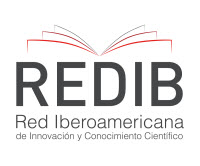
This work is licensed under a Creative Commons Attribution-NonCommercial-ShareAlike 4.0 International License.
Esta obra está bajo licencia internacional https://creativecommons.org/licenses/by-nc-sa/4.0/deed.es
La revista (y sus contenidos) emplean las licencias Creative Commons, específicamente la del tipo CC BY NC SA 4.0, la cual establece que “el beneficiario de la licencia tiene el derecho de copiar, distribuir, exhibir y representar la obra y hacer obras derivadas siempre y cuando reconozca y cite la obra de la forma especificada por el autor o el licenciante”. La licencia del tipo CC BY NC SA 4.0 contempla tres categorías,
- Atribución.
- No Comercialización de la obra.
- Compartir igual
Los lectores son libres de:
- Compartir — copiar y redistribuir el material en cualquier medio o formato
- Adaptar — remezclar, transformar y construir a partir del materialLa licenciante no puede revocar estas libertades en tanto usted siga los términos de la licencia
- Siempre y cuando se respeten y contemplen la atribución de autoría y la no comercialización del material.
Abstract
To achieve a successful supply chain, it is crucial that all supply chain members collaborate. However, this may be a difficult task to achieve because supply chain collaboration assumes that links are willing to cooperate and that there are no inherent conflicts happening within the supply chain network. In practice, organizations may not want to cooperate. Therefore, this paper identifies and addresses a number of dilemmas that arise when supply chain members involve in collaboration. These include forecasting, pricing, delivery, risk, and sharing of information. In addition, this paper shows how evaporating clouds is used to expose the inherent dilemma of supply chain collaboration. Further, this paper attempts to apply the TOC approach to overcome this core conflict. Specifically, it shows how evaporating clouds can be used as a tool to convince immediate supply chain members that the solution to the supply chain collaboration core conflict arrives in the form of TDD/IDD measures. These collaborative performance metrics, when implemented effectively, help in identifying the constraint(s) and thereby, encourage TOC-based continuous improvement efforts to generate value by increasing revenues and reducing overall costs simultaneously across an SC network.
Keywords:
References
Cao, Mei; Zhang, Qingyu (2011). "Supply chain collaboration: Impact on collaborative advantage and firm performance". Journal of Operations Management. 29 (3): 163–180. doi:10.1016/j.jom.2010.12.008
Gibson, B. J., Hanna, J. B., Deffee, C. C., & Chen, H. 2014. The definitive guide to integrated supply chain management: optimize the interaction between supply chain processes, tools, and technologies. Upper Saddle River, NJ: Pearson Education.
Goldratt, Eliyahu M. Theory of Constraints Handbook. Edited by James F. Cox and John G. Schleier, McGraw-Hill, 2010.
Goldratt, E.M. 1994. It's not luck. Great Barrington, MA: North River Press.
Gupta, M., Boyd, L., & Kuzmits, F. (2011). The evaporating cloud: a tool for resolving workplace conflict. International Journal of Conflict Management, 22(4), 394–412. doi: 10.1108/10444061111171387
Gupta, Mahesh, and Soeren Andersen., 2018. “Throughput/Inventory Dollar-Days: TOC-Based Measures for Supply Chain Collaboration.” International Journal of Production Research, vol. 56, no. 13, pp. 4659–4675., doi:10.1080/00207543.2018.1444805.
2012
Gupta, M., Chahal, H., Kaur, G., & Sharma, R. (2010). Improving the weakest link: A TOC-based framework for small businesses. Total Quality Management & Business Excellence, 21(8), 863–883. doi: 10.1080/14783363.2010.483108
Holt, James R., and Scott D. Button. “Integrating Strategy and Tactics Across Multiple Business Units: The Supply Chain Solution.” SAE Technical Paper Series, 2000, doi:10.4271/2000-01-1767.
Horvath, L. 2001. "Collaboration: the key to value creation in supply chain management." Supply Chain Management Vol. 6 No. 5, pp. 205-207.
Kampstra, R. P., Ashayeri, J., & Gattorna, J. L. 2006. “Realities of Supply Chain Collaboration.” SSRN Electronic Journal. doi: 10.2139/ssrn.919813.
Kohli, Amarpreet S., and John B. Jensen. (2010). “Assessing Effectiveness of Supply Chain Collaboration: An Empirical Study.” Supply Chain Forum: An International Journal, vol. 11, no. 2, 2010, pp. 2–16., doi:10.1080/16258312.2010.11517228.
Ralston, Peter. 2014. "Supply chain collaboration: A literature review and empirical analysis to investigate uncertainty and collaborative benefits in regards to their practical impact on collaboration and performance.” Graduate Theses and Dissertations. 13798.
Simatupang, T. M., Hun, B. B., & Sridharan, R. (2004). “Applying the theory of constraints to supply chain collaboration.” Supply Chain Management: An International Journal, 9(1), 57–70. doi: 10.1108/13598540410517584

















